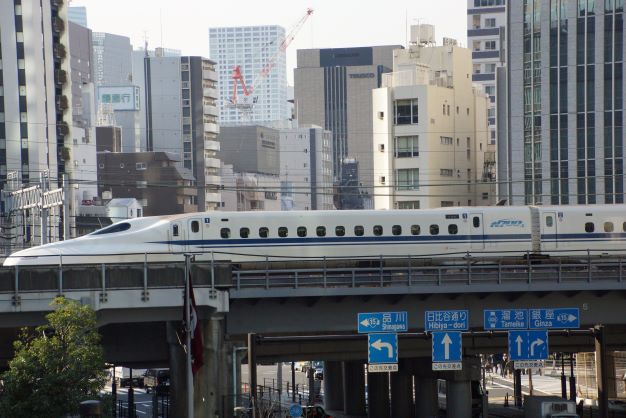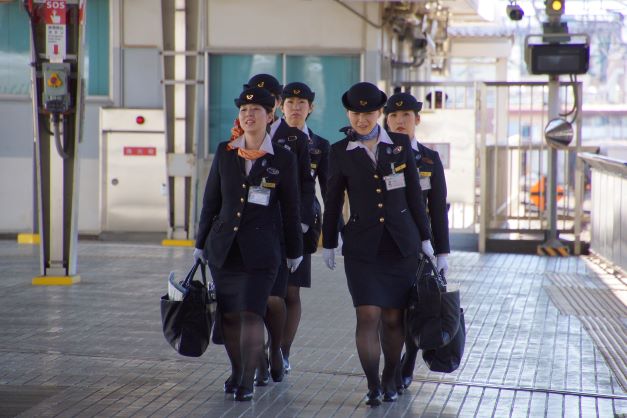Setting aside trips to Okinawa and Hokkaido (islands), the vast majority of Japanese have never taken a domestic airplane trip. And why would they? A handful of countries have well-developed high-speed railway systems, but Japan remains by far the world leader in terms of reach, efficiency, comfort and safety.
In the 1950s Japan began investing heavily in high-speed rail transport as an alternative to air travel, which was starting to boom worldwide. Trains provided a practical transportation solution for a country that imported nearly all its fossil fuels and saw the majority of its population concentrated on the Pacific coastal plain.
Of course, the years following World War II were difficult in Japan, as they were in Europe. The economy had been devastated, and much of the country’s infrastructure had been destroyed. But when Tokyo was awarded the 1964 Olympic Games, Japan hoped they would serve as its post-war coming out party.
On October 1, 1964, nine days before the opening ceremonies, the first Shinkansen arrived in Shin-Osaka Station from Tokyo, having cut travel time between Japan’s two largest cities from six hours 40 minutes to only four hours.
Today the Shinkansen, dubbed “the bullet train” for its aerodynamic shape, has served over 11 billion passengers while maintaining an enviable on-time record. In 2018, the average Shinkansen finished its run within 54 seconds of its scheduled arrival time. One reason the service is so efficient is hinted at in the translation of shinkansen, which means “new trunk line”; because the Shinkansen runs on dedicated track, slower traffic is not an issue.
Dedicated track also contributes to operational safety. In 52 years, Japan’s Shinkansen has never recorded an operations-related fatality (though several deaths have been recorded due to suicide and other passenger misadventure). Japan’s Shinkansen operators have also pioneered many of the technological developments that have driven the growth of high-speed rail transportation around the world, addressing issues such as aerodynamics, noise, vibration, earthquake safety and energy consumption. For example, the energy consumption per seat for travel between Tokyo and Osaka is approximately 12 percent of that of an aircraft; the CO2 emission rate is around 8 percent.
Today, the fastest Shinkansen travel time between Tokyo and Osaka is two hours and 22 minutes, but construction and testing are underway for a next generation magnetically levitated (maglev) train that in April 2015 set a world record speed of 603 km/h.
The Central Japan Railway Company (JR Central) expects to begin service between Tokyo and Nagoya in 2027, and to extend service from Nagoya to Osaka in 2045, cutting travel times between Tokyo and Nagoya from one hour and 41 minutes to only 40 minutes (!), and between Tokyo and Osaka from two hours and 22 minutes to 67 minutes (!).
The total cost of the project, estimated at USD35bn in 2007, had escalated to over USD64bn by 2021, but JR Central estimates that maglev ticket prices will be only slightly more expensive than existing Shinkansen service. Don’t expect there to be much of a view, however; about 90 percent of the 286-kilometer Tokyo-Nagoya route will be underground or in tunnels through the mountains.
The Shinkansen is Japan’s preferred method for long-distance travel, but the country relies even more on short-haul trains, which carry over 7.2 billion passengers a year, mostly to and from work.
As an example, Tokyo’s Yamanote Line, which circles the city in a 29-station loop, carries 3.68 million passengers per day. In comparison, London’s Underground carries 3.36 million passengers per day on 12 lines serving 275 stations. New York City’s subway system carries 5.08 million passengers per day riding on 26 lines serving 469 stations.
But Japan’s railway system is a hodgepodge of different companies, mostly privately owned and operated. In Tokyo alone, 48 companies operate 158 lines, and serve around 40 million passengers a day. Indeed, 46 of the world’s 50 busiest railway stations are in Japan, with Tokyo’s Shinjuku Station by far the busiest, serving 3.64 million passengers a day.
The world’s highest passenger volumes demand precisely coordinated scheduling, and indeed, the (somewhat exaggerated) reputation of Japanese trains for adherence to schedule was the key to one of Japan’s most famous modern novels. Police detectives in Seicho Matsumoto’s Points and Lines solve a double murder by plotting the victims’ travels exactly via railway timetables.
Trains on Tokyo’s Yamanote Line run 2.5 minutes apart during rush hours, and white-gloved railway employees are on occasion required to shove passengers inside like pork (and herbs) into sausage casings. Shinkansen service between Tokyo and Osaka runs almost as often, with 13 departures an hour – trains carry over 1,300 passengers – during peak periods.
Perhaps unsurprisingly in a country where trains play an important role in many people’s lives, just over 10 years ago the country was swept by Train Man fever. A novel, manga, television series and movie were produced to tell the purportedly true story of a 23-year-old otaku who found love by protecting a young woman on a train from harassment by a drunken salaryman.
In gratitude for his gallantry, the woman took the young man’s address and later sent him an expensive present. The geeky young man, never having had a girlfriend, and indeed, never having been on a date, turned to the Internet (of course!) for advice, and with thousands of supporters offering tips on what to wear, and where to go for dinner, he eventually declared his love for the woman, who reciprocated. The happy couple presumably rode off into the sunset by train. A train that left the station on time.








